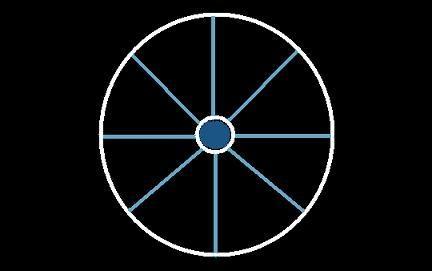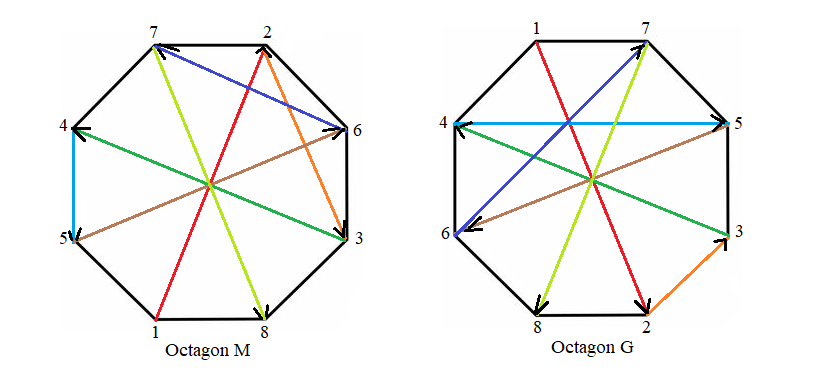Octagon Algorithm for Partial Border Wheel Squares (Part XV)
The Eight Node Way - (a,c,e) Squares
The previous section Part XIV looked at (a,b,c) type squares specifically the 5×5 squares where the initial, central cell number was one and the Octagon M and G algorithms were used for filling in the non spoke cells. Part XV is concerned with the generation of partial border squares where only the internal 3×3 and the outer squares are magic.
For the square to be partially or fully bordered the internal 3×3 square is constructed using a triplet of three numbers to ensure that all the rows columns and diagonals sum to the magic sum 123 for the 7th order. These triplets are labeled as (c,d,r) corresponding to the last cells in the central, diagonal and row spokes adjacent to the center cell in the square and are shown in Table Ib. Those triplets in white correspond to triplets that contain at least one common number with any of the spokes of the wheel:
Table Ib
| Odd c |
| 5,6,7 |
| 7,8,9 |
| 9,10,11 |
| 11,12,13 |
| 13,14,15 |
| 15,16,17 |
| 17,18,19 |
| 19,20,21 |
| 21,22,23 |
The 7×7 Wheel Squares
This section will deal with numbers (after the main diagonal is filled) that run in the order a (top center), c (bottom right) and e (left center) and whose 3×3 inner squares are filled with either of the three triplets from Table Ib. Only those triplets are that have no common numbers in the spokes are used.
The wheel portion of the square is filled according to Part X, using the blue color values from Table Ib to ensure that every row, column and diagonal of the internal 3×3 square adds up to the magic sum of 123. The construction of the square is then completed by the use the M and G algorithms, using graph theory, as was done previously in Part X.
So using the Octagon G and M algorithms seven 7th order squares covering all seven of the blue triplets of Table Ib are constructed:
Border 7a(7,8,9)mg
| 47 | 39 |
14 | 1 |
35 | 11 |
28 |
| 13 | 46 |
18 | 2 |
31 | 27 | 38 |
| 17 | 21 |
42 | 7 |
26 | 29 | 33 |
| 5 | 6 |
9 | 25 |
41 | 44 |
45 |
| 34 | 30 |
24 | 43 |
8 | 20 | 16 |
| 37 | 23 |
32 | 48 |
19 | 4 | 12 |
| 22 | 10 |
36 | 49 |
15 | 40 | 3 |
|
|
Border 7a(9,10,11)mg
| 47 | 42 |
14 | 1 |
35 | 8 |
28 |
| 13 | 46 |
18 | 2 |
31 | 27 | 38 |
| 17 | 21 |
40 | 9 |
26 | 29 | 33 |
| 5 | 6 |
11 | 25 |
39 | 44 |
45 |
| 34 | 30 |
24 | 41 |
10 | 20 | 16 |
| 37 | 23 |
32 | 48 |
19 | 4 | 12 |
| 22 | 7 |
36 | 49 |
15 | 43 | 3 |
|
|
Border 7a(11,12,13)mg
| 47 | 42 |
14 | 1 |
35 | 8 |
28 |
| 10 | 46 |
18 | 2 |
31 | 27 | 41 |
| 17 | 21 |
38 | 11 |
26 | 29 | 33 |
| 5 | 6 |
13 | 25 |
37 | 44 |
45 |
| 34 | 30 |
24 | 39 |
12 | 20 | 16 |
| 40 | 23 |
32 | 48 |
19 | 4 | 9 |
| 22 | 7 |
36 | 49 |
15 | 43 | 3 |
|
Border 7a(13,14,15)mg
| 47 | 42 |
11 | 1 |
38 | 8 |
28 |
| 10 | 46 |
18 | 2 |
31 | 27 | 41 |
| 17 | 21 |
36 | 13 |
26 | 29 | 33 |
| 5 | 6 |
15 | 25 |
35 | 44 |
45 |
| 34 | 30 |
24 | 37 |
14 | 20 | 16 |
| 40 | 23 |
32 | 48 |
19 | 4 | 9 |
| 22 | 7 |
39 | 49 |
12 | 43 | 3 |
|
|
Border 7a(15,16,17)mg
| 47 | 42 |
11 | 1 |
38 | 8 |
28 |
| 10 | 46 |
18 | 2 |
31 | 27 | 41 |
| 14 | 21 |
34 | 15 |
26 | 29 | 36 |
| 5 | 6 |
17 | 25 |
33 | 44 |
45 |
| 37 | 30 |
24 | 35 |
16 | 20 | 13 |
| 40 | 23 |
32 | 48 |
19 | 4 | 9 |
| 22 | 7 |
39 | 49 |
12 | 43 | 3 |
|
|
Border 7a(17,18,19)mg
| 47 | 42 |
11 | 1 |
38 | 8 |
28 |
| 10 | 46 |
15 | 2 |
34 | 27 | 41 |
| 14 | 21 |
32 | 17 |
26 | 29 | 36 |
| 5 | 6 |
19 | 25 |
31 | 44 |
45 |
| 37 | 30 |
24 | 33 |
18 | 20 | 13 |
| 40 | 23 |
35 | 48 |
16 | 4 | 9 |
| 22 | 7 |
39 | 49 |
12 | 43 | 3 |
|
In addition, the Border 7a(19,20,21)mg can be compared with the previous A4 Partial Border square from 2015 Part I constructed using parity where the 3×3 of the A4 square is non magic.
Border 7a(19,20,21)mg
| 47 | 42 |
11 | 1 |
38 | 8 |
28 |
| 10 | 46 |
15 | 2 |
34 | 27 | 41 |
| 14 | 18 |
30 | 19 |
26 | 32 | 36 |
| 5 | 6 |
21 | 25 |
29 | 44 |
45 |
| 37 | 33 |
24 | 31 |
20 | 17 | 13 |
| 40 | 23 |
35 | 48 |
16 | 4 | 9 |
| 22 | 7 |
39 | 49 |
12 | 43 | 3 |
|
|
7a Partial Border
| 47 | 42 |
11 | 1 |
38 | 8 |
28 |
| 10 | 46 |
15 | 2 |
34 | 27 |
41 |
| 14 | 18 |
30 | 19 |
26 | 32 |
36 |
| 5 | 6 |
21 | 25 |
29 | 44 |
45 |
| 37 | 33 |
24 | 31 |
20 | 17 |
13 |
| 40 | 23 |
35 | 48 |
16 | 4 |
9 |
| 22 | 7 |
39 | 49 |
12 | 43 |
3 |
|
|
A4 Partial Border
| 46 | 10 |
13 |
1 | 38 |
39 |
28 |
| 35 | 45 | 19 |
2 | 32 | 27 |
15 |
| 34 | 31 |
44 | 3 |
26 | 21 | 16 |
| 7 | 8 | 9 |
25 | 41 |
42 | 43 |
| 17 | 18 | 24 |
47 | 6 |
30 | 33 |
| 14 | 23 | 29 |
48 | 20 |
5 | 36 |
| 22 | 40 |
37 |
49 | 12 |
11 |
4 |
|
Analysis of square A4 shows that it is composed of three algorithms: an Octagon I reflected along the vertical axis, an Octagon I rotated 180 degrees and an altogether different algorithm with two different graph structures. These three methods will be shown to produce new wheel magic squares where the octagonal algorithm graphs do not follow the usual intersection of four edges at the center of the octagon. See Part XVI for details.
This completes the Octagon M and G method for the 7×7 section. To go to Part XVI.
Go back to Part XIV. Go back to homepage.
Copyright © 2022 by Eddie N Gutierrez. E-Mail: enaguti1949@gmail.com


